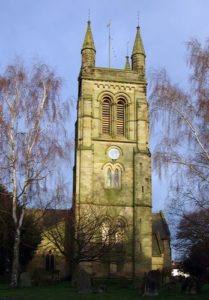There has been a church here since before the Norman Conquest. St Aidan is supposed to have preached here in the 7thC. There seems to have been a church here since before the Norman conquest. Little is known about its history. The present building is a 19thC rebuild, although it still has the Norman south doorway and chancel arch. It is a big church and the murals painted by the Victorians show a triumphalist view of Christian history with Helmsley at the centre.
Set at the north of the Market Place it is surrounded by trees and almost impossible to photograph. The Victorians kept the style of a 13thC church with very tall square tower with corner turrets at the west end, nave, north aisle, transepts and chancel. It is built with ashlar blocks and there are neat corbels round the top of the walls.
Entry is through the south porch which still has the original Norman round arch with chevron carvings. The pillars on either side have nice capitals.
Inside it has a wood barrel ceiling and complex pillars with pointed arches separating the nave and north aisle. At first sight it is a fairly plain church with Victorian bench pews.
Our eyes went to the walls of the north aisle are covered with murals depicting the spread of Christianity in the area. These are shown by a series of ‘trees’ . The Helmsley Tree has branches to the other local parishes. The York tree shows the different dioceses with the date of their foundation and attempts to show the success for St Aidan’s mission. St Cuthbert’s cross hangs from the bottom left branch. He was possibly the most famous of the Celtic saints. The Rievalux tree shows nearby Rievaulx Abbey with its daughter abbeys at the ends of the branches. The windows in the north aisle depict the life of L’Espec a friend of Henry I who was handed the estate.
The panelled roof of the north aisle is painted with red IHC monograms, black and white patterned ribs and painted shield bosses.
There are more murals in the south transept. At the top is St George killing the dragon, which represent God driving Satan from Anglia,. Along the top of the dragon are the names of Norse gods, Woden, Friga, Thor… The rest of the paintings tell the story of St Aidan and St oswald bringing Christianity to the north east. This story is continued in the stained glass windows.
As well as the mural, the south transept contains a splendid reredos above the altar. This is set under a blue canopy with gold stars. In the centre set in a scarlet and gold frame is a painted carving of the Crucifixion with the Virgin MAry and St John on either side of the cross. Above the altar is a row of brightly coloured shields.
The organ occupies part of the north transept. Behind is a small chapel with an altar made of Frosterley marble which is full of fossils. On the wall is a double piscina with a painted statue of Mary and the baby Jesus, with a lit candle.
There is a glorious Norman chancel arch with heads carved round the outer arch and chevron and beaded patterns on the inner arches. The capitals have beak head, scrolls and ram’s horns.Above is a round window with flower tracery. The altar, reredos and altar rails were made by Robert Thompson of Kilburn and have his mouse trade mark. It is a very simple altar with a narrow quadrifoil frieze along the top and a panel of flowered silk in the reredos. Doors on either side lead to the sacristy.
Encaustic tiles on the choir floor have an image of a pelican pecking her breast to feed her young. Panelling on the walls is the war memorial to the 22nd Dragoons who were stationed at Duncombe Park during the Second World War. Their banner hangs from the wall.
The font is under the tower. The guide book mentions the tombstone of Lord Ross of Hamlake which contains the only brass in the church. Don’t get excited. This is small and very worn. Hanging on the walls are the yoke of a liberated slave and medieval pikes. There is also a letter written by Dr Livingstone to Mrs Gray, wife of the Bishop of Cape Town, thanking her for the mosquito net she sent him.
Don’t bother with the guide book to the church. It is full of detail about history, but is confusing and doesn’t give a clear description of the church and what to look for. The description on the “website”:http://www.helmsleyparish.org.uk/ is much better.
The church is open 9-5.
There are more pictures “here.”:http://wasleys.org.uk/eleanor/churches/england/yorkshire/north_yorkshire/north_yorkshire_one/helmsley/index.html










